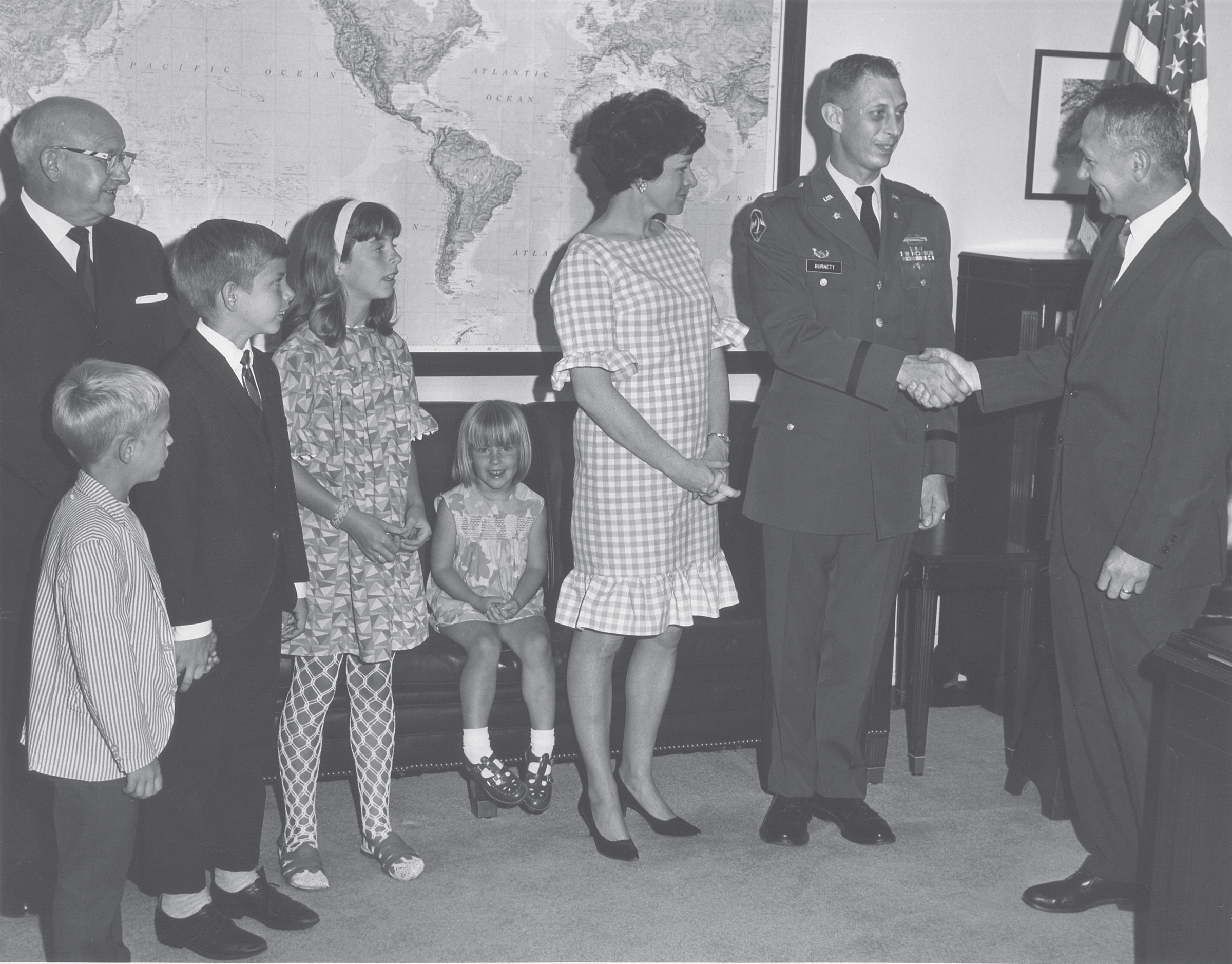|
Sheldon John “Shelly” Burnett, was
born to Dr. and Mrs. Clarence H. Burnett in Milwaukee, WI, on Jun 9, 1931. In
1946, the family moved to northern Wisconsin, where he enrolled in Eagle River
High School. Shelly was a dedicated scholar and achieved Honor Roll status
throughout all of his high school years. He was on the staff of the school
newspaper and a cast member in two class plays. Living in the North Woods, he
became involved with hunting and fishing and, spent many hours at target
practice with pistols and small and large bore rifles, and stayed qualified. He
entered West Point in 1950 with a Congressional Appointment and was highly
successful at everything he undertook, including academics. He continued his
interest in the theatre with a three-year role in stage management for the
venerable Dialectic Society.
While at West Point, he met his future wife,
Maggie. They were one of the first couples to be married in the West Point
Chapel immediately following graduation in 1954. Four children followed: son
Michael “Irish” Burnett (who served eight years in the U.S. Marine Corps),
daughter Leigh Ann, son Steven, and daughter Patricia “Trish” Burnett. While
they were growing up, the kids said he was truly a caring father but also a hard
taskmaster deeply concerned with their education. “There is no sense in settling
for a ‘B', when you can get an ‘A’ for a nickel’s more worth of effort,” was one
of his favorite expressions.
Shelly completed his Armor Officers Basic Course
at Ft. Knox, KY, and Airborne training at Ft. Benning, GA. His first unit
assignment was the 3rd Armored Cavalry Regiment at Ft. Meade, MD, (1955-59)
including his first overseas tour. His squadron was on its way to Europe
at a time of turbulence, including the riots in Poland and Hungary and the
second crisis over Berlin. The squadron returned to Ft. Meade, MD, in 1958.
After the Armor Officers Advanced Course at Ft. Knox, he entered Georgia Tech to
earn a master’s degree in Electrical Engineering. He then was assigned to Ft.
Knox to serve on the Armor Board (1962-65), a test and evaluation group
responsible for overseeing innovation and continuing excellence in Armor.
After graduating from the Command & General Staff College at Ft. Leavenworth, KS
in 1966, Shelly went to Ft. Gordon, GA for several months of jungle warfare
training, followed by language training at the Presidio of Monterrey, CA. By
December 1966, he was off to Vietnam as senior advisor to the 1st Armored
Cavalry Regiment (ARVN), a unit that saw heavy action in the Vietnam delta.
Among his decorations were the Vietnamese Armed Forces Honor Medal First Class
and the Republic of Vietnam Gallantry Cross with Bronze star.

Returning to a Pentagon assignment in December
1967, he served for two years in the office of the Vice Chief of Staff of the
Army, where he worked on such major Armor projects as the M1 Abrams Tank.
Now a lieutenant colonel, Shelly took command of
the 2nd Squadron, 6th
Armored Cavalry Regiment at Ft. Meade until he returned to Vietnam in September
1970 to replace the commander of the 1st Squadron, 1st Cavalry Regiment, 23rd
Infantry Division (AMERICAL). During this Vietnam tour, he earned, among other
decorations, the Purple Heart, two Bronze Stars, the Air Medal for Valor and the
Combat Infantryman Badge.
On Mar 7, 1971, he flew out to join an element of
his A Troop engaged in combat close to the Laotian border. The craft approached
a smoke signal, which proved to be an ambush rather than the planned landing
zone. The Scout helicopter was shot down over Laos, overturned, and Shelly was
pinned under the wreckage, semiconscious. He was declared missing-in-action
(MIA) for 34 years.
Shelly’s daughter, Trish explains how it was during those many years of
separation:
“On Mar 11, 1971, my mother opened the door to a chaplain who advised us that my
father was missing in action. Initially we were relieved that he wasn’t killed
and there was still hope that he would return. The days turned into weeks, the
weeks into months, and the months into many, many years. Our family maintained
hope, but it was surrounded with grief, despair and frustration. “It’s not as
simple as growing up without a father. It was more like having a ghost for a
father. We maintained the hope that he would someday return and sought out the
tiniest ray of light in the darkness.
“Finally, on Feb 2, 2005, 34 years later, we
learned that my father’s remains had been found in a shallow grave, underneath a
tree, only a few feet from the crash site. On Apr 13, 2005 he was buried with
full military honors at Arlington National Cemetery.
“I cried for the father I never really knew. I cried for the years of life he
never really had. But mostly I cried because I was proud of him … his
commitment, his courage, and the ultimate sacrifice that he made. And he
was home now, for good.”
Unfortunately, his son Steven and wife Maggie were unable to be a part of his
homecoming. Steven suffered an accidental death in August of 1973 at age 11, and
Maggie died in October of 1998. Shelly had five grandchildren that he never had
the opportunity to meet.
—Jack Galvin ’54 & family members |
